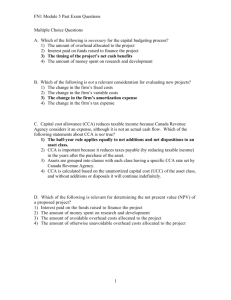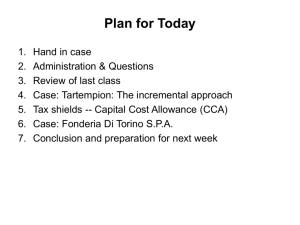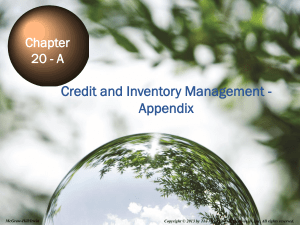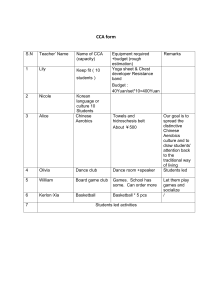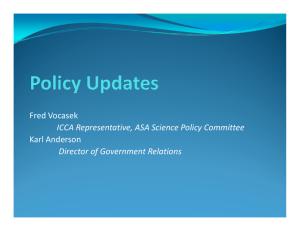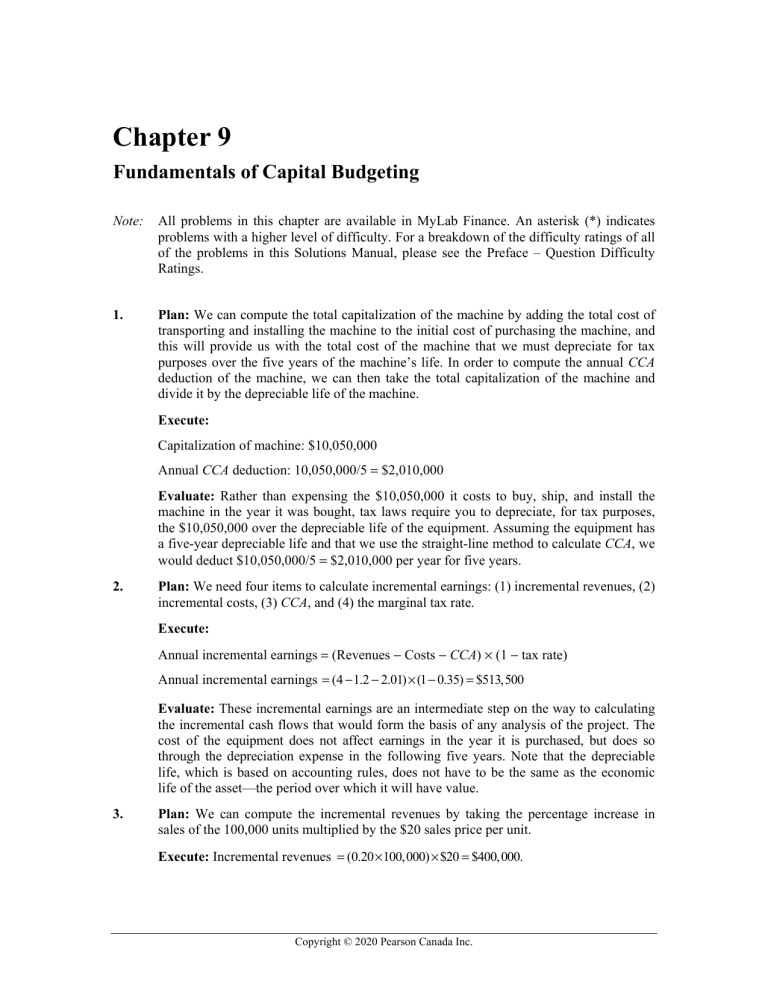
Chapter 9 Fundamentals of Capital Budgeting Note: All problems in this chapter are available in MyLab Finance. An asterisk (*) indicates problems with a higher level of difficulty. For a breakdown of the difficulty ratings of all of the problems in this Solutions Manual, please see the Preface – Question Difficulty Ratings. 1. Plan: We can compute the total capitalization of the machine by adding the total cost of transporting and installing the machine to the initial cost of purchasing the machine, and this will provide us with the total cost of the machine that we must depreciate for tax purposes over the five years of the machine’s life. In order to compute the annual CCA deduction of the machine, we can then take the total capitalization of the machine and divide it by the depreciable life of the machine. Execute: Capitalization of machine: $10,050,000 Annual CCA deduction: 10,050,000/5 = $2,010,000 Evaluate: Rather than expensing the $10,050,000 it costs to buy, ship, and install the machine in the year it was bought, tax laws require you to depreciate, for tax purposes, the $10,050,000 over the depreciable life of the equipment. Assuming the equipment has a five-year depreciable life and that we use the straight-line method to calculate CCA, we would deduct $10,050,000/5 = $2,010,000 per year for five years. 2. Plan: We need four items to calculate incremental earnings: (1) incremental revenues, (2) incremental costs, (3) CCA, and (4) the marginal tax rate. Execute: Annual incremental earnings = (Revenues − Costs − CCA) × (1 − tax rate) Annual incremental earnings = (4 − 1.2 − 2.01) × (1 − 0.35) = $513,500 Evaluate: These incremental earnings are an intermediate step on the way to calculating the incremental cash flows that would form the basis of any analysis of the project. The cost of the equipment does not affect earnings in the year it is purchased, but does so through the depreciation expense in the following five years. Note that the depreciable life, which is based on accounting rules, does not have to be the same as the economic life of the asset—the period over which it will have value. 3. Plan: We can compute the incremental revenues by taking the percentage increase in sales of the 100,000 units multiplied by the $20 sales price per unit. Execute: Incremental revenues = (0.20 × 100,000) × $20 = $400,000. Copyright © 2020 Pearson Canada Inc. 150 Chapter 9: Fundamentals of Capital Budgeting Evaluate: A new product typically has lower sales initially, as customers gradually become aware of the product. Sales will then accelerate, plateau, and ultimately decline as the product nears obsolescence or faces increased competition. Similarly, the average selling price of a product and its cost of production will generally change over time. Prices and costs tend to rise with the general level of inflation in the economy. 4. Plan: We can compute the level of incremental sales associated with introducing the new pizza assuming that customers will spend the same amount on either version by using the sales of the new pizza and the lost sales of the original pizza (40% of customers who switched to the new pizza multiplied by the $20 million in new sales). We can compute the level of incremental sales associated with introducing the new pizza assuming that 50% of the customers will switch to another brand by using the sales of the new pizza and the lost sales of the original pizza from the customers who would not have switched brands. Execute: a. Sales of new pizza − lost sales of original = 20 − 0.40(20) = $12 million. b. Sales of new pizza − lost sales of original pizza from customers who would not have switched brands = 20 − 0.50(0.40)(20) = $16 million. Evaluate: More incremental sales are generated if 50% of the customers who will switch from Pisa Pizza’s original pizza to its healthier pizza will switch to another brand if Pisa Pizza does not introduce a healthier pizza than just the incremental sales associated with introducing the new pizza. A new product typically has lower sales initially, as customers gradually become aware of the product. Sales will then accelerate, plateau, and ultimately decline as the product nears obsolescence or faces increased competition. Similarly, the average selling price of a product and its cost of production will generally change over time. Prices and costs tend to rise with the general level of inflation in the economy. 5. Plan: We need four items to calculate incremental earnings: (1) incremental revenues, (2) incremental costs, (3) depreciation, and (4) the marginal tax rate. Execute: Year 1 2 Incremental Earnings Forecast ($000s) 1 Sales of Mini Mochi Munch 9,000 7,000 2 Other Sales 2,000 2,000 3 Cost of Goods Sold (7,350) (6,050) 4 Gross Profit 3,650 2,950 5 Selling, General & Admin. (5,000) — 6 Depreciation — — (1,350) 2,950 473 (1,033) (878) 1,918 7 EBIT 8 Income Tax at 35% 9 Unlevered Net Income Copyright © 2020 Pearson Canada Inc. Chapter 9: Fundamentals of Capital Budgeting 151 Evaluate: These incremental earnings would form the basis of any analysis of the project. There is no cost of equipment in this project that will affect the earnings of the project. Net income is negative in the first year because the additional selling, general, and administrative costs occurred only in the first year. 6. Plan: We can compute the incremental impact on this year’s EBIT of the drop in price by subtracting the gross profit without the price drop from the gross profit with the price drop. We can compute the incremental impact on EBIT for the next three years of a price drop in the first year from the additional sales on ink cartridges by finding the change in EBIT from ink cartridge sales, which will be the incremental impact on EBIT for years 2 and 3. Note that for year 1, we must remember to subtract the incremental impact on EBIT from the price drop in year one. Execute: a. Change in EBIT = Gross profit with price drop − Gross profit without price drop = 25,000 × (300 − 200) − 20,000 × (350 − 200) = −$500,000 b. Change in EBIT from ink cartridge sales = 25,000 × $75 × 0.70 − 20,000 × $75 × 0.70 = $262,500 Therefore, incremental change in EBIT for the next three years is Year 1: $262,500 − 500,000 = −$237,500 Year 2: $262,500 Year 3: $262,500 Evaluate: A new product typically has lower sales initially, as customers gradually become aware of the product. Sales will then accelerate, plateau, and ultimately decline as the product nears obsolescence or faces increased competition. Similarly, the average selling price of a product and its cost of production will generally change over time. Prices and costs tend to rise with the general level of inflation in the economy. 7. Plan: The difference between incremental earnings and incremental free cash flows is driven by the equipment purchased. We need to recognize the cash outflow associated with the purchase in year 0 and add back the CCA deductions (which were assumed to be the same as the depreciation expenses in Problem 1) from years 1 to 5, as they are not actually cash outflows. Execute: Free cash flows = After-tax earnings + CCA − Capital expenditures − Changes in NWC FCF (this year) = −$10,050,000 FCF (for each of the next five years) = 513,500 + 2,010,000 = $2,523,500 Evaluate: By recognizing the outflow from purchasing the equipment in year 0, we account for the fact that $10,050,000 left the firm at that time. By adding back the CCA in years 1 to 5, we adjust the incremental earnings to reflect the fact that the CCA deduction is not a cash outflow. Copyright © 2020 Pearson Canada Inc. 152 8. Chapter 9: Fundamentals of Capital Budgeting Plan: We can project the net working capital needed for this operation by adding cash, inventory, and receivables and subtracting payables. Execute: Net working capital in this problem is the sum of cash, accounts receivable, and inventory (Lines 1, 2, and 3 below) less accounts payable (Line 4). Line 5 is net working capital and Line 6 is the changes in working capital from year to year. For example, net working capital in year 1 was 14 and in year 2 it grew to 19, so the increase in NWC, as computed on Line 6 for year 2, is 5. The firm must add 5 to working capital in year 2, so it represents a reduction in cash flow available to investors. Year 0 Year 1 Year 2 Year 3 Year 4 Year 5 1 Cash 6 12 15 15 15 2 Accounts Receivable 21 22 24 24 24 3 Inventory 5 7 10 12 13 4 Accounts Payable 18 22 24 25 30 5 Net working capital (1 + 2 + 3 − 4) 14 19 25 26 22 6 Increase in NWC 14 5 6 1 -4 0 Since an increase in NWC is equivalent to a negative cash flow, the cash flow effects are as follows: Cash Flow Year 0 Year 1 Year 2 Year 3 Year 4 Year 5 0 -14 -5 -6 -1 +4 Evaluate: Most projects will require the firm to invest in net working capital. We care about net working capital because it reflects a short-term investment that ties up cash flow that could be used elsewhere. Note that whenever net working capital increases, reflecting additional investment in net working capital, it represents a reduction in cash flow that year. 9. Plan: In order to compute the net working capital for each year we need to compute the receivables and payables for each year as a percentage of sales and COGS (receivables are 15% of sales, and payables are 15% of COGS). Execute: 0 1 2 3 4 Sales $23,500 $26,438 $23,794 $8,566 COGS $ 9,500 $10,688 $ 9,619 $3,483 Receivables: $0 $ 3,525 $ 3,966 $ 3,569 $1,285 Payables: $0 $ 1,425 $ 1,603 $ 1,443 $ 522 NWC: $0 $ 2,100 $ 2,363 $ 2,126 $ 762 $ 2,100 $ −$ −$1,364 Δ NWC (Required Investment): Copyright © 2020 Pearson Canada Inc. 263 236 Chapter 9: Fundamentals of Capital Budgeting 153 Evaluate: Most projects will require the firm to invest in net working capital. We care about net working capital because it reflects a short-term investment that ties up cash flow that could be used elsewhere. Note that whenever net working capital increases, reflecting additional investment in net working capital, it represents a reduction in cash flow that year. 10. Plan: We need four items to calculate incremental earnings: (1) incremental revenues, (2) incremental costs, (3) CCA, and (4) the marginal tax rate. Earnings include non-cash charges, such as CCA, but do not include the cost of capital investment. To determine the project’s free cash flow from its incremental earnings, we must adjust for these differences. We need to add back CCA to the incremental earnings to recognize the fact that we still have the cash flow associated with it. Execute: Solution: Note—we have assumed any incremental cost of goods sold is included as part of operating expenses. a. Year 1 2 Incremental Earnings Forecast ($000s) 1 Sales 125.0 160.0 2 Operating Expenses (40.0) (60.0) 3 CCA (25.0) (36.0) 4 EBIT 60.0 64.0 5 Income tax at 35% (21.0) (22.4) 6 Unlevered Net Income 39.0 41.6 1 2 25.0 36.0 b. Free Cash Flow ($000s) 7 Plus: CCA 8 Less: Capital Expenditures (30.0) (40.0) 9 Less: Increases in NWC (2.0) (8.0) Free Cash Flow 32.0 29.6 10 Evaluate: These incremental earnings are an intermediate step on the way to calculating the incremental cash flows that would form the basis of any analysis of the project. Earnings are an accounting measure of the firm’s performance. They do not represent real profits, and a firm needs cash. Thus, to evaluate a capital budgeting decision, we must determine its consequences for the firm’s available cash. 11. Plan: Earnings include non-cash charges, such as CCA, but do not include the cost of capital investment. To determine the project’s free cash flow from its incremental earnings, we must adjust for these differences. We need to add back CCA to the incremental earnings to recognize the fact that we still have the cash flow associated with it. Copyright © 2020 Pearson Canada Inc. 154 Chapter 9: Fundamentals of Capital Budgeting Execute: FCF = Unlevered net income + CCA − CapEx − Increase in NWC = 250 + 100 − 200 − 10 = $140 million. Evaluate: Earnings are an accounting measure of the firm’s performance. They do not represent real profits, and a firm needs cash. Thus, to evaluate a capital budgeting decision, we must determine its consequences for the firm’s available cash. 12. This opportunity cost lowers the incremental earnings of the SPI Phone 86 project by the after-tax earnings that they would have otherwise earned had they rented out the space instead. This would be a decrease in incremental earnings of -$200,000 × (1 − 0.40) = $120,000 per year for the 4 years. *13. Plan: Incremental EBITDA per year: $40,000 − 20,000 = $20,000 Incremental CapEx: −$150,000 + $50,000 = $100,000 Execute: Replacing the machine increases EBITDA by $40,000 – $20,000 = $20,000. Therefore, FCF excluding CCA tax shields will increase by (20,000) × (1-0.45) = $11,000 in years 1 through 10. PV = 11,000 1 1− = $67,590.24 .10 1.1010 In year 0, the initial cost of the machine is $150,000. Selling the current machine for $50,000 generates an incremental CapEx of $150,000 − $50,000 = $100,000. Thus, the year 0 cash flow is −$100,000. In addition, the incremental CapEx generates CCA tax shields. The PV of CCA tax shields is .10 1+ 100,000 × .40 × .45 2 PV = × = $34,363.64 .10 + .40 (1 + .10 ) The NPV of replacing the machine is thus NPV = −$100,000 + 67,590.24 + 34,363.64 = $1,953.87 Evaluate: Since the NPV ≥ 0, yes, your company should replace the old machine. Even though the decision has no impact on revenues, it still matters for cash flows because it reduces costs. Further, both selling the old machine and buying the new machine involve cash flows with tax implication. Copyright © 2020 Pearson Canada Inc. Chapter 9: Fundamentals of Capital Budgeting *14. 155 Plan: We can use Equation 9.9 to evaluate the free cash flows associated with each alternative. Note that we only need to include the components of free cash flows that vary across each alternative. For example, since NWC is the same for each alternative, we can ignore it. Execute: The spreadsheet below computes the relevant FCF from each alternative. Note that each alternative has a negative NPV—this represents the PV of the costs of each alternative. We should choose the one with the highest NPV (lowest cost), which in this case is to purchase the existing machine. a. See spreadsheet. Notes to calculations in spreadsheet: After-tax amounts for rent, maintenance, and other costs are calculated as follows: After-tax amount = Before-tax amount × (1 − τC) For example, the after-tax rent cash flow = −$50,000 × (1 − .35) = −$32,500 PV CCA tax shields are calculated as follows: r .08 1+ 1 + CapEx × d × τ C 2 150, 000 × .25 × .35 2 × = × = $38, 299.66 Option A: PV = r+d Option B: PV = CapEx × d × τ C r+d (1 + r ) .08 + .25 (1 + .08 ) r .08 1 + 250, 000 × .25 × .35 1 + 2 2 = × × = $63,832.77 (1 + r ) .08 + .25 (1 + .08) NPVs of free cash flows excluding CCA tax shields (FCF) are calculated as follows: 10 FCFt t =0 (1 + r )t NPV = b. See spreadsheet. Evaluate: When evaluating a capital budgeting project, financial managers should make the decision that maximizes NPV. In this case, Big Rock Brewery should purchase the current machine because it has the lowest negative NPV. 15. a. No, this is a sunk cost and will not be included directly. (But see part (f) below.) b. Yes, this is a cost of opening the new store. c. Yes, this loss of sales at the existing store should be deducted from the sales at the new store to determine the incremental increase in sales that opening the new store will generate for HBS. d. No, this is a sunk cost. Copyright © 2020 Pearson Canada Inc. 156 Chapter 9: Fundamentals of Capital Budgeting e. This is a capital expenditure associated with opening the new store. These costs will therefore increase HBS’s depreciation expenses (recall that depreciation is usually used for reporting purposes but not for tax purposes). This capital expenditure affects the cash flows of the project by causing a large initial outflow (the construction costs) followed by a series of inflows as the CCA tax shields are realized. f. Yes, this is an opportunity cost of opening the new store. (By opening the new store, HBS forgoes the after-tax proceeds it could have earned by selling the land. This loss is equal to the sale price less the taxes owed on the capital gain from the sale, which is the difference between the sale price and the book value of the land.) g. While these financing costs will affect HBS’s actual earnings, for capital budgeting purposes we calculate the incremental earnings without including financing costs to determine the project’s unlevered net income. 16. a. Using Equations 9.1 and 9.2, the CCA deductions are as follows: Year 0 1 2 3 4 5 UCC 7,500,000.00 13,125,000.00 9,843,750.00 7,382,812.50 5,537,109.38 CCA 1,875,000.00 3,281,250.00 2,460,937.50 1,845,703.13 1,384,277.34 CapEx 15,000,000.00 b. The CCA tax shield in year t is equal to the τC × CCAt Year 0 1 2 3 4 5 656,250.00 1,148,437.50 861,328.13 645,996.09 484,497.07 35% τC CCA tax shield c. The CCA tax shield in year t has present value equal to Year r 0 (1 + r ) t 1 2 3 4 5 656,250.00 1,148,437.50 861,328.13 645,996.09 484,497.07 596,590.91 949,121.90 647,128.57 441,224.02 300,834.56 10% CCA tax shield PV of CCA tax shield NPV of first 5 CCA tax shields τ C × CCAt 2,934,899.96 Copyright © 2020 Pearson Canada Inc. Chapter 9: Fundamentals of Capital Budgeting 157 d. The PV of the perpetuity of CCA tax shields is as follows: r .10 1+ 1 + CapEx × d × τ C 2 15, 000, 000 × .25 × .35 2 PV = × = × = $3,579,545.45 (1 + r ) r+d (1 + .10 ) .10 + .25 e. If the marginal corporate tax rate increases over the next five years, the PV of CCA tax shields will be higher than what is calculated in part (d). In addition, if the tax rate will increase substantially, then Spherical may be better off delaying claiming CCA amounts until later years. The increased CCA tax shield generated in the future may more than make up for the extra discounting required tocompensate for the time value of money. Note, in this case, it may be easier to make a spreadsheet where the tax rates can be adjusted on a year to year basis as we cannot use the formula in part (d) because it assumes that a constant tax rate holds. 17. a. Plan: Before the free cash flows can be calculated, the CCA deductions must be determined and used instead of depreciation. Execute: The CapEx amount is $25 million. Using Equations 9.1 and 9.2, the UCC and CCA amounts are (in $thousands): Year 1 2 3 4 5 6 7 8 9 10 UCC 12,500 21,250 14,875 10,413 7289 5102 3571 2500 1750 1225 CCA 3750 6375 4463 3124 2187 1531 1071 Copyright © 2020 Pearson Canada Inc. 750 525 368 158 Chapter 9: Fundamentals of Capital Budgeting The free cash flows are (in thousands): Year 0 Cost of machine cash flow -25,000 Cash flow from change in net working capital -10,000 1 2 3 4 5 6 7 8 9 10 10,000 Sales revenue 30,000 30,000 30,000 30,000 30,000 30,000 30,000 30,000 30,000 30,000 Minus cost of goods sold 18,000 18,000 18,000 18,000 18,000 18,000 18,000 18,000 18,000 18,000 Equals gross profit 12,000 12,000 12,000 12,000 12,000 12,000 12,000 12,000 12,000 12,000 Minus general, sales and administrative expense 2000 2000 2000 2000 2000 2000 2000 2000 2000 2000 Plus overhead that would have occurred anyway 1000 1000 1000 1000 1000 1000 1000 1000 1000 1000 Minus CCA 3750 6375 4463 3124 2187 1531 1071 750 525 368 Equals net operating income 7250 4625 6538 7876 8813 9469 9929 10,250 10,475 10,632 Minus income tax @ 35% 2538 1619 2288 2757 3085 3314 3475 3587 3666 3721 4713 3006 4249 5120 5729 6155 6454 6662 6809 6911 3750 6375 4463 3124 2187 1531 1071 750 525 368 Equals net income 0 Plus CCA Plus machine and change in net working capital cash flows -35,000 0 0 0 0 0 0 0 0 0 10,000 Equals free cash flow -35,000 8463 9381 8712 8243 7915 7686 7525 7413 7334 17,279 b. The free cash flows in the previous table should not be used to calculate the NPV as there are CCA tax shields in years 11 and onward. If only the free cash flows shown in part (a) are used for the NPV, the result will underestimate the project’s actual NPV. We can calculate the free cash flows excluding CCA effects and calculate the PV of CCA tax shields separately. This is shown below. Copyright © 2020 Pearson Canada Inc. Chapter 9: Fundamentals of Capital Budgeting Year 0 Cost of machine cash flow -25,000 Cash flow from change in net working capital -10,000 1 2 3 4 5 6 7 159 8 9 10 10,000 Sales revenue 30,000 30,000 30,000 30,000 30,000 30,000 30,000 30,000 30,000 30,000 Minus cost of goods sold 18,000 18,000 18,000 18,000 18,000 18,000 18,000 18,000 18,000 18,000 Equals gross profit 12,000 12,000 12,000 12,000 12,000 12,000 12,000 12,000 12,000 12,000 Minus general, sales and administrative expense 2000 2000 2000 2000 2000 2000 2000 2000 2000 2000 Plus overhead that would have occurred anyway 1000 1000 1000 1000 1000 1000 1000 1000 1000 1000 Minus CCA not included as analyzed separately Equals net operating income 11,000 11,000 11,000 11,000 11,000 11,000 11,000 11,000 11,000 11,000 Minus income tax @ 35% 3850 3850 3850 3850 3850 3850 3850 3850 3850 3850 Equals net income 7150 7150 7150 7150 7150 7150 7150 7150 7150 7150 Plus CCA not included as analyzed separately Plus cost of machine and change in net working capital cash flows -35,000 0 0 0 0 0 0 0 0 0 10,000 Equals free cash flow excluding CCA tax shields -35,000 7150 7150 7150 7150 7150 7150 7150 7150 7150 17,150 (Note: Consistent with the tables above, all dollar values are expressed in $thousands.) NPV of FCFexcluding CCA tax shields = −35, 000 + 7,150 1 17,150 1− + = 4,992.66 .14 1.149 1.1410 .14 1 + 25, 000 × 0.30 × .35 2 × = 5,599.58 PV of CCA tax shields = .14 + .30 1 + .14 NPV = 4,992.66 + 5,599.58 = $10,592.25 Evaluate: Since the project’s NPV is positive, it should be accepted. *18. Plan: It is best to calculate the FCF excluding CCA tax shields, take the NPV of these FCF’s and then add the PV of CCA tax shields to get the NPV. Then compute the NPV under different assumptions about initial revenues and growth. Then compute the NPV of the project under a range of discount rates. Copyright © 2020 Pearson Canada Inc. Chapter 9: Fundamentals of Capital Budgeting Execute: a. The PV CCA tax shields are as follows: r .12 1+ 1+ CapEx × d × τ C 2 150, 000 × .10 × .35 2 × = × = $22,585.23 PV = r+d (1 + r ) (1 + .12) .12 + .10 The FCF’s excluding CCA tax shields, their NPV, and the total NPV including CCA tax shields are calculated in the table below ($millions): b. Revenue 10% higher 10% lower (see spreadsheet file for details) NPV $86.91971 $13.46681 c. Growth Rate NPV 0% $50.19326 2% 5% (see spreadsheet file for details) $65.38491 $91.06262 d. NPV is positive for discount rates below the IRR of 19.41% NPV give n diffe re nt discount ra te s 140.0 120.0 100.0 80.0 60.0 N P V 160 40.0 20.0 0.0 0% 5% 10% 15% 20% -20.0 -40.0 -60.0 Discount ra te s (r) Copyright © 2020 Pearson Canada Inc. 25% 30% 35% Chapter 9: Fundamentals of Capital Budgeting 161 Evaluate: Under the forecast assumptions the project has an NPV of $50.2 million and therefore should be accepted. Under various scenarios of assumed initial sales and growth the project continues to have a positive NPV, meaning that even if the forecast assumption proves too optimistic or pessimistic the project will still create firm value. Finally the discount rate used in the forecast assumptions is 12%, but the project would have a positive NPV using any discount rate below 19.41%. The project is positive and the results are robust. *19. Copyright © 2020 Pearson Canada Inc. 162 Chapter 9: Fundamentals of Capital Budgeting 20. Real options must have positive value because they are only exercised when doing so would increase the value of the investment. If exercising the real option would reduce value, managers can allow the option to go unexercised. Thus, having the option but not the obligation to act is valuable. 21. The XC-900 allows Buckingham the option to expand production starting in year 3. If it would be beneficial to expand production, Buckingham will increase production with the XC-900. If it would be better if production remains the same, Buckingham is under no obligation to utilize all of the XC-900 production capacity. 22. This provides Buckingham the option to abandon the investment. Copyright © 2020 Pearson Canada Inc.
